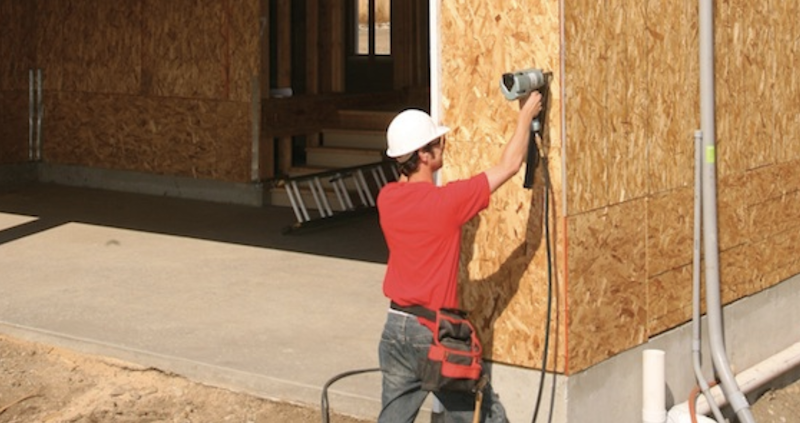Sometimes it’s the simple things that can make the difference between quality construction and satisfied customers and the home construction that dogs you with callbacks and complaints.
The typical errors that we see in the field are both common and highly preventable. Reducing callbacks is all about paying attention to detail and keeping up with wood construction systems that deliver the best structural and building science performance. While home construction isn’t a field known for its technological advancements, there are, in fact, important developments in building materials and systems that significantly improve both the building’s performance and the buyer’s satisfaction with the home.
Top 10 Wood Framing Errors
1. Sheathing installed as a simple span
Sheathing should be installed over two or more spans, or three supports, at a minimum.
2. The strength axis is installed in the wrong direction
In general, panels should be installed with the long dimension or strength axis of the panel across supports.
3. Sheathing is ripped less than 24 inches and not properly supported
A narrow-width panel will deflect more than a panel 24 inches or greater in width. These panels are often installed on roof ridges, where workers are likely to walk during construction. The addition of blocking or edge-support clips will provide narrow-width panels with the support needed to handle heavy loads.
4. Glulam is installed upside down
When glulam beams are manufactured as unbalanced beams, there are different bending stresses assigned to the compression and tension zones, and the beams must be installed accordingly. When “Top” is stamped on the top lamination, that end of the beam should be up.
5. Panels are not spaced 1/8 inch at installation
Wood structural panels (plywood and OSB), like all wood products, will expand or shrink slightly with changes in moisture content. If expansion is prevented with tightly butted panel joints, buckling can occur. To prevent buckling and ensure optimum performance, the panel end and edge joints should be spaced 1/8 inch.
6. Overdriven fasteners
Improper fastening — including incorrect fastener location or size, or installation of fasteners through the panel and into the framing member — can result in structural and aesthetic problems that commonly lead to callbacks.
7. Inconsistent joist spacing
If the floor doesn’t “feel right” to the homeowner, you can expect a callback. A consistent deflection across the entire floor will keep the customer happy.
8. Inconsistent floor gluing
The number-one complaint about floors is squeaking. A properly glued-nailed floor system will work as a homogeneous unit, preventing most floor squeaks.
9. Improper water management
It’s important to prevent moisture intrusion in the building envelope and to allow for proper drying when moisture does get in.
10. Notching and hole cutting in the wrong places
Improperly made field notches or holes may reduce the structural capacity or the load-carrying capability of the structural framing member.
New Plate Washer Requirements for Engineered Shear Walls
New provisions in the 2009 and 2012 International Building Code will require the use of plate washers on most sill plate anchor bolts in engineered structures, such as multi-family and commercial projects, as well as one- and two-family homes designed using the IBC.
Although builders in high-seismic regions have been using plate washers since the late 1990s to improve the performance of wood shear walls, this requirement will be new for most low-seismic regions, according to Shane Vilasineekul, P.E., branch engineering manager with Simpson Strong-Tie. Vilasineekul offers a few important details to keep in mind:
- The purpose of the new requirement is to limit the tendency for sill plates to split length wise between the anchor bolts. This can occur when anchor bolts are supporting the center of the sill plate while the sheathing pulls up on the edge of the sill plate, creating a prying action.
- The new plate washer requirements apply to shear walls designed under the IBC. There are no changes to the plate washer provisions prescribed in the International Residential Code, which only requires plate washers in high-seismic regions or when designing for extreme winds.
- The plate washer must be a minimum 3 x 3 x 0.229 inches (3 gauge) and extend to within ½-inch of the sheathed edge of the sill plate.
- To allow for larger tolerances in anchor bolt placement, the code permits the plate washer to be slotted when a standard cut washer is used.
- New, slotted plate washers that are 4½-inch wide can be used for 2x6 framing that is sheathed on both sides or for anchor bolts centered in 2x6 framing that is sheathed on just one side.

5 Wood Framing Principles for Preventing Common Errors
1. Wood has a strength direction
Adhere to this principle and avoid many deflection problems.
2. Wood expands and contracts
Buckling is the most common complaint in sheathing applications. Properly space panels to avoid these preventable callbacks.
3. Consistency counts
Inconsistent alignment, framing, materials, nailing, spacing, spans, and gluing all create problems — both real and perceived — for homeowners. Many of these problems can be avoided with consistent building practices.
4. Moisture is the enemy
Prevent moisture intrusion by paying special attention to housewraps, flashing, shingling of underlayments, and use of vapor retarders. This is vital to preventing moisture-related problems.
5. Load-path continuity
Continuous sheathing and proper fasteners will provide uplift resistance against high winds.
RELATED
-
For more on load-path continuity, watch APA's webinar After the Storm: Building for High Wind Resistance
This last principle is a big one. While wood-frame construction makes it easy for builders to construct strong, durable buildings, wall studs alone can’t withstand high wind and seismic forces. A continuous load path safely transfers the lateral, vertical, and racking loads caused by severe weather and earthquakes from the roof, wall, and floor systems to the foundation. The continuous load path is achieved by connecting the structural frame, wood structural panel sheathing, and fasteners together. The result is like a chain that ties the house together from the roof to the foundation. If any link in the chain breaks, the overall structural system could weaken. If each link is strong enough to handle the applied loads, however, a continuous load path will provide tremendous resistance against the forces of nature.
The Importance of Wall Bracing
Wall bracing is one of the most important structural elements of any house, but it can also be one of the most confusing. Wood structural panel sheathing is the easiest and most economical way to meet International Residential Code prescriptive bracing requirements. Continuous sheathing with wood structural panels provides superior bracing to resist uplift loads, lateral loads, and wind pressures while providing a secure connection to the roof and protecting the occupants. Additionally, wood structural panel sheathing provides impact resistance from storm-blown objects and holds fasteners securely for siding application.
Connection Quality Is Also Key
Fasteners are the final link in the chain, and the effectiveness of the structural system relies on the quality and quantity of the connections. In hurricanes, the loss of roofing materials and sheathing is the leading cause of structural failure in wood-framed buildings. The central reasons behind these failures are improper connection detailing between structural systems and inadequate fastening of sheathing to supporting members. Understanding connection detailing and adhering to a prescribed fastener schedule is critical to completing the load path.
By adhering to these framing principles, paying attention to details, and maintaining a commitment to understanding wood frame systems, builders can reduce callbacks, satisfy homeowners, and increase profits.
Founded in 1933, APA represents approximately 160 plywood, oriented strand board, glulam timber, wood I-joist, rim board, and laminated veneer lumber mills throughout the U.S. and Canada. Its primary functions are quality auditing and testing, applied research, and market support and development.
More wood framing resources
- The Best Way to Frame: Less Wood, More Thought
- Best Practices for Designing and Framing Engineered Wood Floor Systems
- Energy Efficient Framing Guide
Advertisement
Related Stories
Sales + Marketing
7 Sales and Marketing Trends to Watch (and Learn From)
These award-winning campaigns from NAHB's 2024 National Sales and Marketing Awards showcase next-level strategies and stellar results
Construction
Proven Ways to Improve Jobsite Productivity
Consider these solutions for reducing cycle time, hard costs, dry runs, rework, miscommunication, and overall inefficiencies on the jobsite
Sales
Sales and Texting? Know the Rules
Texting your sales prospects en masse can be an efficient way to get your message through if you follow these best practices







